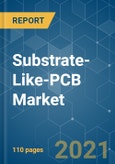The substrate-like-PCB market is expected to grow at a CAGR of 12% during the forecast period (2021 - 2026). Owing to the rising adoption of substrate-like-PCB in OEMs, smart consumer electronics and wearable devices, there is a growth of the substrate-like-PCB market. The need for miniaturization and efficient interconnect solutions is also contributing to substrate-like PCB market growth. At present market is heavily dependent on high-end smartphone growth. For instance, Huawei started to produce substrate-like-PCB for the Premium phone P30 Pro released in March 2019.
Key Market Trends
Consumer Electronics to Augment the Market Growth
Asia-Pacific to be Fastest Growing Market
Competitive Landscape
The substrate-like-PCB market is consolidated because the majority of the market share is owned by top players in the industry. Some of the key players include Kinsus Interconnect Technology Corp., Ibiden Co.Ltd., Compeq Manufacturing Co. Ltd., Daeduck Electronics Co. Ltd., Unimicron Technology Corporation, Zhen Ding Technology, Meiko Electronics, TTM Technologies, AT&S, among others.
Reasons to Purchase this report:
This product will be delivered within 2 business days.
- Industry experts have identified an increasing amount of focus on reducing the size of electronic packages, to reduce power consumption and boost functionality. All the miniaturized components need to be arranged within a limited dimension, which is not feasible in conventional printed circuit boards (PCBs). This limitation is driving the need for the substrate-like-PCB market.
- One of the key substrate-like-PCB market trends is the development of an advanced system in package (SiP) modules. The application of SiP modules is increasing due to benefits like bundling of communication units like Wi-Fi, modem, and Bluetooth in one package. SiP modules offer effective performance at a lower cost and are significantly smaller in size when compared to a set of individual modules. As a result, there will be a continuous increase in the utilization of SiP modules by OEMs.
- With the rising trends in technologies such as IoT, 5G, smart cars, it is required that the size of the PCB would be miniaturized and the substrates become much more powerful. Thus, substrate-like-PCB will be used at a massive scale to support these technological trends.
- However, the higher setup cost associated with substrate-like-PCB can hinder the growth of the market.
Key Market Trends
Consumer Electronics to Augment the Market Growth
- Consumer electronics include smartphones, tablets, smart bands, fitness bands, wearables, and others. Increasing demand for consumer electronics expected to provide opportunities to players in the substrate-like-PCB market.
- With the use of substrate-like-PCB, there will be more space for the battery in a smartphone as substrate-like-PCB will allow for thinner connections between critical components such as the DRAM, NAND flash memory, and application processor. With the use of substrate-like-PCB, the number of layers can be increased, reducing the width and board area by 30% compared to the existing one.
- Moreover, in the next five-year smartphone market across the world will burgeon due to the adaption of smartphone and penetration of the internet. This will increase the growth of the substrate-like-PCB market. The smartphone manufacturers are miniaturizing the devices such that devices become portable and easier to handle. However, the demand for the miniaturization of packages and the growth of IoT will drive the need for substrate-like-PCB modules across the globe.
Asia-Pacific to be Fastest Growing Market
- Asia-Pacific is an emerging market for substrate-like PCBs as it has become a global focal point for significant investments and business expansion opportunities. Globally, more than half of the mobile subscribers live in Asia-Pacific, such as in China and India. Moreover, there has been a paradigm shift of users from 3G to 4G technology in this region.
- Key factors that are driving the substrate-like-PCB market growth in Asia-Pacific region include the increasing adoption of smartphones, rising demand for connectivity solutions, a growing number of internet users, expanding bandwidth-intensive applications and expansion of telecommunications infrastructure in the region. Majority of the smartphone providers are from the Asia-Pacific region; it is expected that there would be a significant demand for substrate-like-PCB in the Asia-Pacific region during the forecast period.
- Substrate-like-PCB manufacturers from South Korea, Taiwan, and Japan are dominating production activities. For instance, players like Taiwan-headquartered ZD Tech and japan-headquartered Meiko are expanding new substrate-like-PCB production lines in Vietnam and China for more than one smartphone customer. Taiwan has become one of the major places for the development of substrate-like-PCB technology. Certainly, China will gain substrate-like-PCB technical know-how progressively with technology transfer from the major player.
Competitive Landscape
The substrate-like-PCB market is consolidated because the majority of the market share is owned by top players in the industry. Some of the key players include Kinsus Interconnect Technology Corp., Ibiden Co.Ltd., Compeq Manufacturing Co. Ltd., Daeduck Electronics Co. Ltd., Unimicron Technology Corporation, Zhen Ding Technology, Meiko Electronics, TTM Technologies, AT&S, among others.
- June 2019 - TTM Technologies, Inc., a leading global printed circuit board and radio frequency components manufacturer, announced that it will acquire certain manufacturing and intellectual property assets from i3 Electronics, Inc. in order to strengthen its advanced technology PCB capabilities and IP portfolio for emerging applications in the aerospace and defense end market and high-end commercial customers. The acquired technology is an alternative approach to achieve similar lines and spacing as the modified semi-additive process (mSAP) that TTM technologies utilize in their mobility business.
Reasons to Purchase this report:
- The market estimate (ME) sheet in Excel format
- 3 months of analyst support
This product will be delivered within 2 business days.
Table of Contents
1 INTRODUCTION
4 MARKET DYNAMICS
5 MARKET SEGMENTATION
6 COMPETITIVE LANDSCAPE
Companies Mentioned (Partial List)
A selection of companies mentioned in this report includes, but is not limited to:
- Kinsus Interconnect Technology Corp.
- Ibiden Co.Ltd.
- Compeq Manufacturing Co. Ltd.
- Daeduck Electronics Co. Ltd.
- Unimicron Technology Corporation
- Zhen Ding Technology
- TTM Technologies
- Meiko Electronics
- AT&S
- Korea Circuit
- LG Innotek
- Samsung Electro - Mechanics
Methodology

LOADING...








